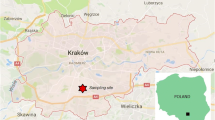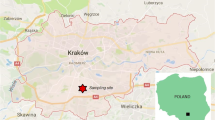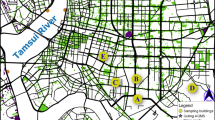Abstract
This source apportionment research was one of the first attempts to quantify the contributions of pollution sources to ambient particulate matter (PM2.5) in the urban area of Skopje. The sampling was conducted at two locations in the city of Skopje, with permanent, year-round coverage. The elemental composition of PM2.5 aerosols was analyzed with non-destructive energy dispersive X-ray fluorescence spectroscopy, water-soluble ions were analyzed photometrically, and black carbon was assessed with an optical transmissometer. Positive Matrix Factorization was used for data modelling, and the contribution of each source to total particulate mass (PM2.5) was calculated. Seven main pollution sources were identified for both sites including biomass burning, open fire burning, traffic, fuel/residual oil burning, industry, and soil/mineral dust. Biomass combustion continues to be the largest single source of ambient air pollution and, due to its particular temporal distribution, is most likely the primary cause of extreme wintertime pollution episodes. Despite being fully seasonal, biomass burning provides the greatest annual relative contribution, reaching 32% for the Novo Lisiche site and 33% for the Karposh site, and during the winter months, this source alone contributes beyond the annual PM2.5 limit levels. Traffic is the second most important source. The annual relative contribution of traffic to the total particle mass at the Novo Lisiche site was 23%, and at the Karposh site, it was 18%. Other notable sources include the combustion of fuel/residual oil, soil dust, and open fires burning.








Similar content being viewed by others
Availability of Data and Materials
The datasets generated during and/or analyzed during the current study are available from the corresponding author on reasonable request.
References
Crippa, P., Castruccio, S., Archer-Nicholls, S., et al. (2016). Population exposure to hazardous air quality due to the 2015 fires in Equatorial Asia. Science and Reports, 6, 37074. https://doi.org/10.1038/srep37074
World health statistics 2023: Monitoring health for the SDGs, Sustainable Development Goals. Geneva: World Health Organization; 2023. Licence: CC BY‑NC‑SA 3.0 IGO.
EEA Briefing no. 23/2023 - Harm to human health from air pollution in Europe: burden of disease 2023, EN HTML: TH-AM-23–026-EN-Q - ISBN: 978–92–9480–614–7 - ISSN: 2467–3196. https://doi.org/10.2800/721439
Madjar, A., Gjorshoska, I., Prodanova, J., Dedinec, A., & Kocarev, L. (2023) Western Balkan societies’ awareness of air pollution. Estimations using natural language processing techniques. Ecological Informatics, 75, 102097. ISSN 1574–9541. https://doi.org/10.1016/j.ecoinf.2023.102097
Mirakovski, D., Boev, B., & Boev, I., et al. (2019). Wintertime urban air pollution in Macedonia – Composition and source contribution of air particulate matter, Proceedings of the 18th World Clean Air Congress, pp 492–500.
Almeida, S. M., Manousakas, M., Diapouli, E., et al. (2020). Ambient particulate matter source apportionment using receptor modelling in European and Central Asia urban areas. Environmental Pollution, 266(3), 115–199. https://doi.org/10.1016/j.envpol.2020.115-199
Belis, C. A., Pisoni, E., Degraeuwe, B., Peduzzi, E., Thunis, P., Monforti-Ferrario, F., & Guizzardi, D. (2019). Urban pollution in the Danube and Western Balkans regions: The impact of major PM2.5 sources. Environment International, 133, 105–158. https://doi.org/10.1016/j.envint.2019.105158
MoEPP (2016). Air quality improvement plan for Skopje agglomeration, Finish Meteorological Institute and Ministry of Environment and Physical Planning, Skopje.
Tehnolab (2019). Integrated Polluters Inventory for Skopje, Skopje.
Kovacevik, B., Wagner, A., Boman, J., Laursen, J., & Pettersson, B. (2011). Elemental composition of fine particulate matter (PM2.5) in Skopje. FYR of Macedonia. X-ray Spectrom., 40, 280–288.
Anttila, P., Stefanovska, A., Nestorovska-Krsteska, A., Grozdanovski, L., Atanasov, I., Golubov, N., & Walden, J. (2016). Characterisation of extreme air pollution episodes in an urban valley in the Balkan Peninsula. Air Quality, Atmosphere and Health, 9, 129–141.
Kendrovski, V. (2006). The impact of ambient temperature on mortality among the urban population in Skopje, Macedonia during the period 1996–2000. BMC Public Health, 6, 44.
Kendrovski, V., Spasenovska, M., & Menne, B. (2014). The public health impacts of climate change in the former Yugoslav Republic of Macedonia. International Journal of Environmental Research and Public Health, 11, 5975–5988.
Sanchez Martinez, G., Spadaro, J. V., Chapizanis, D., Kendrovski, V., Kochubovski, M., & Mudu, P. (2018). Health impacts and economic costs of air pollution in the metropolitan area of Skopje. International Journal of Environmental Research and Public Health 15, 626. https://doi.org/10.3390/ijerph15040626
Belis, C. A., Favez, O., Mircea, M., Diapouli, E., Manousakas, M. I., Vratolis, S., Gilardoni, S., Paglione, M., Decesari, S., Mocnik, G., Mooibroek, D., Salvador, P., Takahama, S., Vecchi, R., & Paatero, P. (2019). European guide on air pollution source apportionment with receptor models - Revised version 2019, EUR 29816 EN. Publications Office of the European Union, Luxembourg. https://doi.org/10.2760/439106,JRC117306
Markert, B., Wünschmann, S., & Baltrėnaitė, E. (2012). Innovative observation of the environment. Bioindicators and biomonitors: Definitions, strategies and applications, Journal of Environmental Engineering and Landscape Management, 20(3), 221–239. https://doi.org/10.3846/16486897.2011.633338
Miasayedava, L., Kaugerand, J., & Tuhtan, J. A. (2023). Lightweight assimilation of open urban ambient air quality monitoring data and numerical simulations with unknown uncertainty. Environmental Modeling and Assessment, 28, 961–975. https://doi.org/10.1007/s10666-023-09909-x
Goswami, P., Prakash, M., & Ranjan, R. K., et al. (2023). A hybrid deep learning model for multi-step ahead prediction of PM2.5 concentration across India. Environmental Modeling and Assessment, 28, 803–816. https://doi.org/10.1007/s10666-023-09902-4
MAKStat Database https://makstat.stat.gov.mk/, State Statical Office, Assessed on 21.04.2022.
Standard operating procedure for PM2.5 cation analysis, revision 7, August 2009, Environmental and Industrial Sciences Division RTI International, Research Triangle Park, North Carolina.
Annexure-A: Air quality sampling and operational procedure. (2018). https://www.teriin.org/sites/default/files/2018-08/Annexures.pdf
Model standard operating procedures for sampling and analysis, CPCB and ASEM-GTZ, Delhi. http://learning-cleanairasia.org/lms/library/ga2/05-Model-Standard-Operating-Procedures-(SOPs)-for-Sampling-and-Analysis.pdf
Standard operating procedure for the analysis of anions and cations in PM2.5 speciation samples by ion chromatography, MLD064, Revision 1.0 (2018) Northern Laboratory Branch Monitoring and Laboratory Division, California Air Resources Board. https://ww2.arb.ca.gov/sites/default/files/2018-10/mld064.pdf
Lee, E., Chan, C. K., & Paatero, P. (1999). Application of positive matrix factorization in source apportionment of particulate pollutants in Hong Kong. Atmospheric Environment, 33, 3201–3212.
Polissar, A. V., Hopke, P. K., Paatero, P., Kaufmann, Y. J., Hall, D. K., Bodhaine, B. A., Dutton, E. G., & Harris, J. M. (1999). The aerosol at Barrow, Alaska: Long-term trends and source locations. Atmospheric Environment, 33, 2441–2458.
Aimanant, S., & Ziemann, P. J. (2013). Development of spectrophotometric methods for the analysis of functional groups in oxidized organic aerosol. Aerosol Science and Technology, 47(6), 581–591. https://doi.org/10.1080/02786826.2013.773579
Juntto, S., & Paatero, P. (1994). Analysis of daily precipitation data by positive matrix factorization. Environmetrics, 5, 127–144.
**e, Y., & Berkowitz, C. M. (2006). The use of positive matrix factorization with conditional probability functions in air quality studies: An application to hydrocarbon emissions in Houston, Texas. Atmospheric Environment, 40, 3070–3091.
Begum, B. A., Kim, E., Biswas, S. K., & Hopke, P. K. (2004). Investigation of sources of atmospheric aerosol at urban and semi-urban areas in Bangladesh. Atmospheric Environment, 38, 3025–3038.
Bzdusek, P. A., Christensen, E. R., Lee, C. M., Pakadeesusuk, U., & Freedman, D. C. (2006). PCB congeners and dechlorination in sediments of Lake Hartwell, South Carolina, determined from cores collected in 1987 and 1988. Environmental Science and Technology, 40, 109–119.
DelValls, T. A., Forja, J. M., González-Mazo, E., & Gómez-Parra, A. (1998). Determining contamination sources in marine sediments using multivariate analysis. Trends in analytical chemistry, 17, 181–192.
Singh, K. P., Malik, A., Singh, V. K., & Sinha, S. (2006). Multi-way data analysis of soils irrigated with wastewater. A case study. Chemometrics and Intelligent Laboratory Systems, 83, 1–12.
Soonthornnonda, P., & Christensen, E. R. (2008). Source apportionment of pollutants and flows of combined sewer wastewater. Water Research, 42, 1989–1998.
Hopke, P. K. (2003). Recent developments in receptor modeling. Journal of chemometrics, 17, 255–265.
Paatero, P., & Tapper, U. (1994). Positive Matrix Factorization: A non-negative factor model with optimal utilization of error estimates of data values. Environmetrics, 5, 111–126.
Reimann, C., Filzmoser, P., & Garrett, R. G. (2002). Factor analysis applied to regional geochemical data: Problems and possibilities. Applied Geochemistry, 17, 185–206.
Anttila, P., Paatero, P., Tapper, U., & Järvinen, O. (1995). Source identification of bulk wet deposition in Finland by positive matrix factorization. Atmospheric Environment, 14, 1705–1718.
Ammato, F., Pandolfi, M., Escrig, A., et al. (2009). Quantifying road dust resuspension in urban environment by multilinear engine: A comparison with PMF2. Atmospheric Environment, 43, 2770–2780.
Putaud, J. P., Van Dingenen, R., Alaustey, A., Bauer, H., Birmili, W., et al. (2010). A European aerosol phenomenology – 3: Physical and chemical characteristics of particulate matter from 60 rural, urban, and kerbside sites across Europe. Atmospheric Environment, 44, 1308–1320.
Larsen, B. R., Gilardoni, S., Stenström, K., Niedzialek, J., Jimenez, J., & Belis, C. A. (2012). Sources for PM air pollution in the Po Plain, Italy: II. Probabilistic uncertainty characterization and sensitivity analysis of secondary and primary sources, Atmospheric Environment, 50, 203–213. https://doi.org/10.1016/j.atmosenv.2011.12.038
Argyropoulos, G., Manoli, E., Kouras, A., & Samara, C. (2012). Concentrations and source apportionment of PM10 and associated major and trace elements in the Rhodes Island, Greece. Science of the Total Environment, 432, 12–22. https://doi.org/10.1016/j.scitotenv.2012.05.076
Argyropoulos, G., Grigoratos, Th., Voutsinas, M., & Samara, C. (2013). Concentrations and source apportionment of PM10 and associated elemental and ionic species in a lignite-burning power generation area of southern Greece. Environmental Science and Pollution Research, 20, 7214–7230. https://doi.org/10.1007/s11356-013-1721-y
Bernardoni, V., Vecchi, R., Valli, G., Piazzalunga, A., & Fermo, P. (2011). PM10 source apportionment in Milan (Italy) using time-resolved data. Science of the Total Environment, 409(22), 4788–4795. https://doi.org/10.1016/j.scitotenv.2011.07.048
SPECIEUROPE data base, https://source-apportionment.jrc.ec.europa.eu/Specieurope/sources.aspx. Assessed on 21.04.2022.
Bove, M. C., Brotto, P., Cassola, F., Cuccia, E., Massabò, D., Mazzino, A., et al. (2014). An integrated PM2. 5 source apportionment study: Positive matrix factorisation vs. the chemical transport model CAMx. Atmospheric environment, 94, 274–286. https://doi.org/10.1016/j.atmosenv.2014.05.039
Diapouli, E., Manousakas, M., Vratolis, S., Vasilatou, V., Maggos, Th., Saraga, D., Grigoratos, Th., Argyropoulos, G., Voutsa, D., Samara, C., & Eleftheriadis, K. (2017). Evolution of air pollution source contributions over one decade, derived by PM10 and PM2.5 source apportionment in two metropolitan urban areas in Greece. Atmospheric Environment, 164, 416–430. https://doi.org/10.1016/j.atmosenv.2017.06.016
Zhang, X., Hecobian, A., Zheng, M., Frank, N. H., & Weber, R. J. (2010). Biomass burning impact on PM2.5 over the southeastern US during 2007: Integrating chemically speciated FRM filter measurements, MODIS fire counts and PMF analysis. Atmospheric Chemistry and Physics, 10, 6839–6853. https://doi.org/10.5194/acp-10-6839-2010
Lee, S., Liu, W., Wang, Y., Russell, A. G., & Edgerton, E. S. (2008). Source apportionment of PM 2.5: Comparing PMF and CMB results for four ambient monitoring sites in the southeastern United States. Atmospheric Environment, 42, 4126–4137.
Duvall, R. M., Majestic, B. J., Shafer, M. M., Chuang, P. Y., Simoneit, B. R. T., & Schauer, J. J. (2008). The water-soluble fraction of carbon, sulfur, and crustal elements in Asian aerosols and Asian soils. Atmospheric Environment, 42, 5872–5884. https://doi.org/10.1016/j.atmosenv.2008.03.028
Sun, Y., Zhuang, G., Tang, A., Wang, Y., & An, Z. (2006). Chemical characteristics of PM2.5 and PM10 in haze−fog episodes in Bei**g. Environmental Science and Technology, 40, 3148–3155. https://doi.org/10.1021/es051533g
Zhou, Y., Zheng, N., Luo, L., Zhao, J., Qu, L., Guan, H., **ao, H., Zhang, Z., Tian, J., & **ao, H. (2020). Biomass burning related ammonia emissions promoted a self-amplifying loop in the urban environment in Kunming (SW China). Atmospheric Environment, 118–138, 2020. https://doi.org/10.1016/j.atmosenv.2020.118138
Paulot, F., Paynter, D., Ginoux, P., Naik, V., Whitburn, S., Van Damme, M., Clarisse, L., Coheur, P. F., & Horowitz, L. W. (2017). Gas-aerosol partitioning of ammonia in biomass burning plumes: Implications for the interpretation of spaceborne observations of ammonia and the radiative forcing of ammonium nitrate. Geophysical Research Letters, 44(15), 8084–8093. https://doi.org/10.1002/2017GL074215
Pant, P., & Harrison, R. M. (2012). Critical review of receptor modelling for particulate matter: A case study of India. Atmospheric Environment, 49, 1–12.
Pant, P., & Harrison, R. M. (2013). Estimation of the contribution of road traffic emissions to particulate matter concentrations from field measurements: A review. Atmospheric Environment, 77, 78–97. https://doi.org/10.1016/j.atmosenv.2013.04.028
Grigoratos, T., & Martini, G. (2019). Brake wear particle emissions: A review. Environmental Science and Pollution Research, 22, 2491–2504. https://doi.org/10.1007/s11356-014-3696-8
Piscitello, A., Bianco, C., Casasso, A., & Sethi, R. (2021). Non-exhaust traffic emissions: Sources, characterization, and mitigation measures. Science of the Total Environment, 766, 144440. https://doi.org/10.1016/j.scitotenv.2020.144440
Smichowski, P., Gómez, D., Frazzoli, C., & Caroli, S. (2007). Traffic-related elements in airborne particulate matter. Applied Spectroscopy Reviews, 43, 23–49.
Liao, H. T., Chou, C. C. K., Chow, J. C., Watson, J. G., Hopke, P. K., & Wu, C. F. (2015). Source and risk apportionment of selected VOCs and PM2.5 species using partially constrained receptor models with multiple time resolution data. Environmental Pollution, 205, 121–130.
Yu, L., Wang, G., Zhang, R., Zhang, L., Song, Y., Wu, B., Li, X., An, K., & Chu, J. (2013). Characterization and source apportionment of PM2.5 in an urban environment in Bei**g. Aerosol Air Qual. Res., 13, 574–583. https://doi.org/10.4209/aaqr.2012.07.0192
Karagulian, F., Belis, C. A., Dora, C. F. C., Prüss-Ustün, A. M., Bonjour, S., Adair-Rohani, H., & Amann, M. (2015). Contributions to cities’ ambient particulate matter (PM): A systematic review of local source contributions at global level. Atmospheric Environment, 120, 475–483. https://doi.org/10.1016/j.atmosenv.2015.08.087
Włodarczyk-Gębik, A., Gabriel, A., Dubis, M., & Machowska, M. (2022). KTP—Collectively improving air quality in Krakow: A new air quality plan for the Małopolska region. In: Deserti, A., Real, M., Schmittinger, F. (eds) Co-creation for responsible research and innovation. Springer Series in Design and Innovation, 15, Springer, Cham. https://doi.org/10.1007/978-3-030-78733-2_7
Traczyk, P., & Gruszecka-Kosowska, A. (2020). The condition of air pollution in Kraków, Poland, in 2005–2020, with health risk assessment. International Journal of Environmental Research and Public Health, 17(17), 6063. https://doi.org/10.3390/ijerph17176063
Funding
AMBICON UGD Lab prepared the Source Apportionment Study for the Skopje Agglomeration as part of the Tackling Air Pollution in the City of Skopje Project, which was implemented by UNDP Skopje and SIDA, the Swedish government agency for development cooperation, with support from the Ministry of Environment and Physical Planning and the City of Skopje.
Author information
Authors and Affiliations
Contributions
D.M. and B.B. initiated the research and paper. D.M. and A.Z. wrote the main manuscript text and realize the modelling and prepared all figures. M.HN., N.D., I.B. and G.D. had obligations around the sampling procedure.
A.Z. and T.SI. analyzed filters using XRF E.D. and A.M.—analyzed water-soluble ions using spectrometry and black carbon using Optical Transmissometer. All authors reviewed the manuscript.
Corresponding author
Ethics declarations
Ethical Approval
Not applicable.
Competing Interests
Not includes interests of a financial or personal nature.
Additional information
Publisher's Note
Springer Nature remains neutral with regard to jurisdictional claims in published maps and institutional affiliations.
Supplementary Information
Below is the link to the electronic supplementary material.
Rights and permissions
Springer Nature or its licensor (e.g. a society or other partner) holds exclusive rights to this article under a publishing agreement with the author(s) or other rightsholder(s); author self-archiving of the accepted manuscript version of this article is solely governed by the terms of such publishing agreement and applicable law.
About this article
Cite this article
Mirakovski, D., Zendelska, A., Boev, B. et al. Evaluation of PM2.5 Sources in Skopje Urban Area Using Positive Matrix Factorization. Environ Model Assess (2024). https://doi.org/10.1007/s10666-024-09961-1
Received:
Accepted:
Published:
DOI: https://doi.org/10.1007/s10666-024-09961-1




